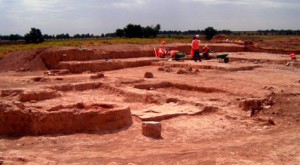 Remains of the Golden Woman in the West Kazakhstan region were recently recognised by scientists as the most ancient burial found in Kazakhstan.
Remains of the Golden Woman in the West Kazakhstan region were recently recognised by scientists as the most ancient burial found in Kazakhstan.
“Based on the results of laboratory studies, it was found that the burial relates to the 6th-5th century BC and is the oldest of the ‘golden’ burials found in Kazakhstan,” Aidar Batyrkhanov, head of the department of culture, archives and documentation of the West Kazakhstan region said at a May 6 press conference.
The Golden Woman burial was discovered in 2012 at the Taksay 1 complex of the West Kazakhstan region. The burial dates back to the Sarmatian period.
This is the burial of a noble female priestess in appropriate attire and headdress. Next to her, about 80 gold ornaments were found: a mirror, a knife, a bronze cauldron and an altar. The wooden comb, which was also found in the burial mound and which depicts the battle scenes in the war of Sakas and Persians, is considered by scientists a unique artifact.
According to Batyrkhanov, scientists from Japan, Germany and Russia were involved in the study, research and restoration of the remains of the Golden Woman and discovered artifacts. Currently, works on design of the Golden woman exhibition are underway.
In order to promote the historical and cultural heritage, two sculptures of the Golden Woman were made, the catalogue “Early Nomads of Western Kazakhstan” (on the example of Taksay complex)” and the booklet “The Crest of Taksay” were published.


